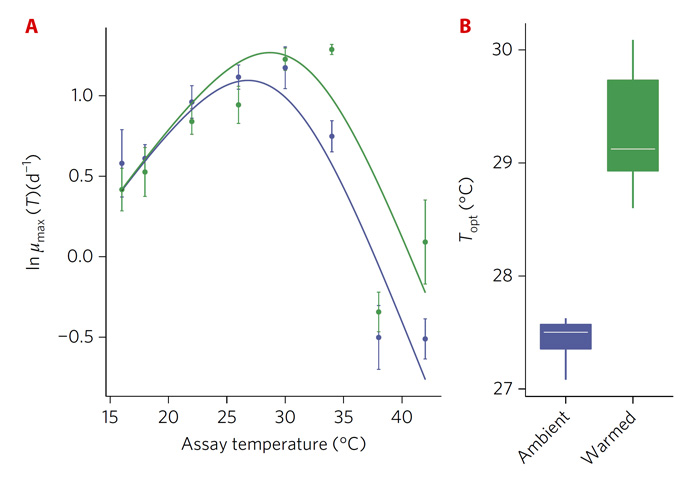| Tweet | Follow @co2science |
Paper Reviewed
Schaum, C.-E., Barton, S., Bestion, E., Buckling, A., Garcia-Carreras, B., Lopez, P., Lowe, C., Pawar, S., Smirnoff, N., Trimmer, M. and Yvon-Durocher, G. 2017. Adaptation of phytoplankton to a decade of experimental warming linked to increased photosynthesis. Nature Ecology & Evolution 1: Article 0094, doi: 10.1038/s41559-017-0094.
Introducing their work, Schaum et al. (2017) state that "there are currently major concerns that global warming will reduce aquatic net primary production, due to increased nutrient limitation, and because rates of respiration and zooplankton grazing tend to be more sensitive to rising temperatures than those of photosynthesis." And, they also correctly note that "these projections, however, do not account for the capacity for phytoplankton to adapt rapidly to environmental change," which omission is a potentially a source of significant error in such projections. Consequently, it was the objective of this team of eleven researchers to investigate this important topic of rapid adaptation to warming.
To meet this objective, Schaum et al. examined the impact of temperature on the thermal adaptation of Chlamydomonas reinhardtii, a common green alga, by growing the algae at eight temperatures (16, 18, 22, 26, 30, 34, 38 and 42 °C). The algae used in the experiment were sourced from a decade-long experiment conducted at twenty freshwater outdoor mesocosms located at the Freshwater Biological Association's river laboratory in East Stoke, Dorset, UK (2.17°W, 50.22°N) that were set up to mimic shallow lake ecosystems under ambient and ambient +4°C temperatures. It was their hypothesis that "evolutionary changes in metabolic traits, which increase net photosynthesis and thereby the potential for carbon allocation to growth, ... play a role in adaptation to long-term warming in populations of C. reinhardtii."
In discussing their findings, Schaum et al. first note that the warmed mesocosms had previously been shown to "have higher algal species richness, greater biomass and faster rates of in situ photosynthesis." And in the present study, they report that "isolates from warmed mesocosms had higher optimal growth temperatures than their counterparts from ambient treatments" (see figure below). Additionally, they found that "warm-adapted isolates were stronger competitors at elevated temperature and experienced a decline in competitive fitness in ambient conditions, indicating adaptation to local thermal regimes," which higher competitive fitness in the warmed isolates "was linked to greater photosynthetic capacity and reduced susceptibility to photoinhibition."
Consequently, in light of all of the above findings, Schaum et al. conclude they "suggest that adaptive responses to warming in phytoplankton could help to mitigate projected declines in aquatic net primary production by increasing rates of cellular net photosynthesis." And this response is extremely important, given that phytoplankton photosynthesis accounts for approximately 40% of the CO2 that is fixed annually across the globe.

Figure 1. Panel A: Thermal reaction norms for growth rate across temperatures ranging from 16 to 42 °C, demonstrating that isolates of C. reinhardtii from the warmed mesocosms had higher optimal temperatures than their ambient counterparts. Panel B: Box and whisker plot of the replicate-level optimum temperatures (Topt), illustrating that median values for Topt were higher in warmed (29.12 ± 0.55 °C) than the ambient (27.5 ± 0.32 °C) isolates. Source: Schaum et al. (2017).




